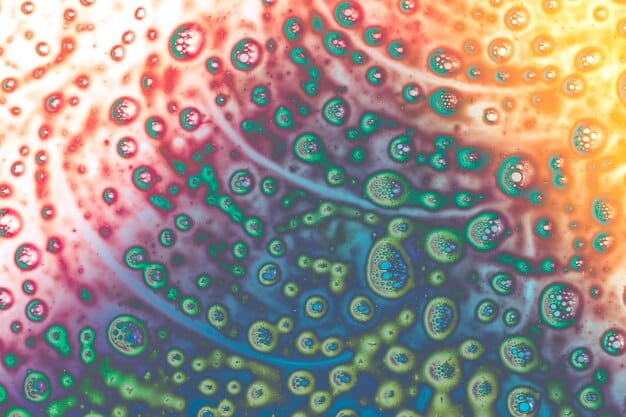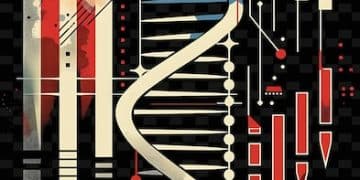Decoding the Science of Aging: Can We Slow It Down?

Decoding the Science of Aging: Can We Really Slow Down the Aging Process? explores the multifaceted nature of aging, from genetic influences to lifestyle interventions, examining current scientific research aimed at extending lifespan and improving healthspan.
The quest to understand and potentially slow down aging has captivated scientists and the public alike. But can we really decode the science of aging and manipulate the aging process?
Understanding the Hallmarks of Aging
Aging isn’t simply about the passage of time; it’s a complex biological process influenced by a myriad of factors. Understanding these factors is crucial to decoding the science of aging: can we really slow down the aging process? and developing effective interventions.
The Nine Hallmarks of Aging
Scientists have identified nine key hallmarks of aging, which represent the underlying mechanisms driving the aging process. Targeting these hallmarks could potentially lead to strategies for slowing down aging and improving healthspan.
- Genomic Instability: Accumulation of DNA damage.
- Telomere Attrition: Shortening of telomeres, protective caps on chromosomes.
- Epigenetic Alterations: Changes in gene expression without altering the DNA sequence itself.
- Loss of Proteostasis: Impaired protein folding and clearance.
- Mitochondrial Dysfunction: Decline in mitochondrial function and energy production.
- Cellular Senescence: Accumulation of senescent cells, which release inflammatory signals.
- Stem Cell Exhaustion: Decline in the regenerative capacity of stem cells.
- Altered Intercellular Communication: Changes in communication between cells, including inflammation.
- Deregulated Nutrient Sensing: Imbalances in nutrient signaling pathways.
Each of these hallmarks contributes to the overall aging process, and targeting them individually or in combination may offer potential strategies for intervention.

Understanding these hallmarks provides a roadmap for research aimed at developing interventions that can slow down or reverse the aging process.
The Role of Genetics in Aging
Our genes play a significant role in determining our lifespan and susceptibility to age-related diseases. While lifestyle factors are important, our genetic makeup sets the stage for how we age. Exploring the role of genetics is vital in decoding the science of aging: can we really slow down the aging process?
Identifying Longevity Genes
Researchers have identified several genes associated with exceptional longevity. Studying these genes can provide insights into the mechanisms that promote healthy aging and protect against age-related diseases.
One example is the FOXO3 gene, which has been linked to increased lifespan in several species, including humans. Variations in this gene have been associated with reduced risk of cardiovascular disease, type 2 diabetes, and cancer.
Another gene of interest is SIRT1, which encodes a protein involved in DNA repair, metabolism, and inflammation. Activation of SIRT1 has been shown to extend lifespan in various model organisms.
Epigenetics and Aging
Epigenetics refers to changes in gene expression that do not involve alterations in the DNA sequence itself. These changes can be influenced by environmental factors and play a crucial role in aging.
DNA methylation, a type of epigenetic modification, has been shown to change with age. These age-related changes in DNA methylation can affect gene expression and contribute to age-related diseases.
Understanding the interplay between genetics and epigenetics is crucial for developing personalized interventions that can promote healthy aging.
Genetic research offers promising avenues for understanding and potentially influencing the aging process.
Dietary Interventions for Longevity
What we eat has a profound impact on our health and lifespan. Certain dietary patterns and specific nutrients have been shown to promote longevity and protect against age-related diseases. Investigating dietary interventions is key to decoding the science of aging: can we really slow down the aging process?

Caloric Restriction
Caloric restriction, reducing calorie intake without causing malnutrition, has been shown to extend lifespan in various model organisms, including yeast, worms, flies, and rodents.
The mechanisms underlying the benefits of caloric restriction are complex but involve reduced oxidative stress, improved insulin sensitivity, and activation of longevity-related genes like SIRT1.
Intermittent Fasting
Intermittent fasting (IF) involves cycling between periods of eating and fasting. Different IF protocols exist, such as the 16/8 method (eating within an 8-hour window and fasting for 16 hours) and the 5:2 diet (eating normally for 5 days and restricting calories for 2 days).
IF has been shown to have similar benefits to caloric restriction, including improved insulin sensitivity, reduced inflammation, and increased autophagy (a cellular process that removes damaged components).
Specific Nutrients and Supplements
Certain nutrients and supplements have also been linked to longevity and healthy aging.
- Resveratrol: A polyphenol found in red wine, grapes, and berries, resveratrol has been shown to activate SIRT1 and have antioxidant and anti-inflammatory effects.
- Curcumin: A compound found in turmeric, curcumin has potent anti-inflammatory and antioxidant properties.
- Omega-3 Fatty Acids: These essential fatty acids, found in fatty fish like salmon and tuna, have been shown to reduce inflammation and protect against cardiovascular disease.
Dietary interventions offer a powerful way to influence the aging process and promote healthy aging.
The Power of Exercise and Physical Activity
Regular exercise is one of the most effective strategies for promoting health and longevity. Physical activity has numerous benefits, including improved cardiovascular health, stronger bones and muscles, and enhanced cognitive function. Understanding the power of exercise is important in decoding the science of aging: can we really slow down the aging process?
Benefits of Exercise on Cellular Aging
Exercise has been shown to have a positive impact on cellular aging processes.
Studies have demonstrated that regular exercise can help maintain telomere length, protecting against the shortening of these protective caps on chromosomes that occurs with age.
Exercise also stimulates mitochondrial biogenesis, increasing the number and function of mitochondria, the powerhouses of our cells.
Types of Exercise for Longevity
Both aerobic exercise (e.g., running, swimming, cycling) and resistance training (e.g., weightlifting) are beneficial for healthy aging.
- Aerobic Exercise: Improves cardiovascular health, increases energy expenditure, and reduces the risk of chronic diseases.
- Resistance Training: Builds muscle mass and strength, improves bone density, and helps maintain metabolism.
- Flexibility and Balance Exercises: Important for maintaining mobility and preventing falls, especially in older adults.
The key is to find activities you enjoy and can stick with long-term. Aim for at least 150 minutes of moderate-intensity aerobic exercise or 75 minutes of vigorous-intensity aerobic exercise per week, along with resistance training twice a week.
Exercise is a powerful tool for promoting healthy aging and extending lifespan.
Emerging Therapies and Technologies
Scientists are continually developing new therapies and technologies aimed at slowing down or reversing the aging process. Some of these approaches are still in the early stages of research, but they hold great promise for the future. Exploring emerging therapies is crucial to decoding the science of aging: can we really slow down the aging process?
Senolytics
Senolytics are drugs that selectively eliminate senescent cells, which accumulate with age and release inflammatory signals that contribute to age-related diseases.
Several senolytic drugs are currently being tested in clinical trials for various age-related conditions, such as osteoarthritis, idiopathic pulmonary fibrosis, and frailty.
Gene Therapy
Gene therapy involves delivering genetic material into cells to correct genetic defects or enhance gene expression.
Researchers are exploring gene therapy approaches to target specific aging-related genes, such as SIRT1 and FOXO3, with the goal of increasing lifespan and healthspan.
Stem Cell Therapy
Stem cell therapy involves using stem cells to repair or replace damaged tissues and organs.
While stem cell therapy has shown promise in treating certain age-related conditions, such as osteoarthritis and macular degeneration, further research is needed to assess its long-term safety and efficacy.
Emerging therapies and technologies offer exciting possibilities for intervening in the aging process.
The Importance of Mental and Social Well-being
While physical health is crucial for longevity, mental and social well-being are equally important. Maintaining a positive mindset, managing stress, and staying connected with others can significantly impact our overall health and lifespan. Acknowledging mental health is relevant to decoding the science of aging: can we really slow down the aging process?
Stress Management
Chronic stress can have detrimental effects on our health, accelerating aging and increasing the risk of age-related diseases.
Techniques for managing stress include:
- Meditation: Practicing mindfulness and meditation can help reduce stress and improve mental clarity.
- Yoga: Yoga combines physical postures, breathing exercises, and meditation, promoting both physical and mental well-being.
- Spending Time in Nature: Exposure to nature has been shown to reduce stress and improve mood.
Social Connection
Strong social connections are essential for maintaining mental and physical health. Social isolation and loneliness have been linked to increased risk of chronic diseases and premature mortality.
Engaging in social activities, volunteering, and spending time with loved ones can help combat loneliness and promote social well-being.
Mental and social well-being are integral components of healthy aging and longevity.
| Key Aspect | Brief Description |
|---|---|
| 🧬 Genetics | Genes influence lifespan and susceptibility to diseases. |
| 🥗 Diet | Caloric restriction and intermittent fasting can boost longevity. |
| 💪 Exercise | Physical activity improves cardiovascular health and cellular function. |
| 🧠 Mental Health | Managing stress and staying connected are crucial. |
Frequently Asked Questions
▼
While stopping aging entirely is unlikely, scientific research suggests that slowing down the rate of aging is possible through lifestyle interventions and emerging therapies.
▼
The key hallmarks of aging include genomic instability, telomere attrition, epigenetic alterations, loss of proteostasis, mitochondrial dysfunction, cellular senescence, stem cell exhaustion, altered intercellular communication, and deregulated nutrient sensing.
▼
Dietary interventions like caloric restriction and intermittent fasting have been shown to extend lifespan and improve healthspan by reducing inflammation and improving cellular function.
▼
Yes, regular exercise is crucial for healthy aging. It improves cardiovascular health, strengthens bones and muscles, enhances cognitive function, and has positive effects on cellular aging processes.
▼
Senolytics are drugs that selectively eliminate senescent cells, which accumulate with age and release inflammatory signals that contribute to age-related diseases, showing promise in treating age-related conditions.
Conclusion
Decoding the science of aging is an ongoing endeavor that holds immense promise for extending lifespan and improving healthspan. By understanding the underlying mechanisms of aging and implementing lifestyle interventions, we can potentially slow down the aging process and live longer, healthier lives.





